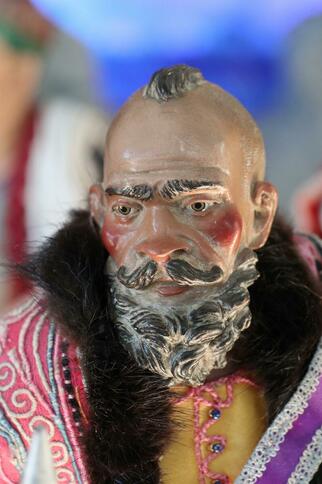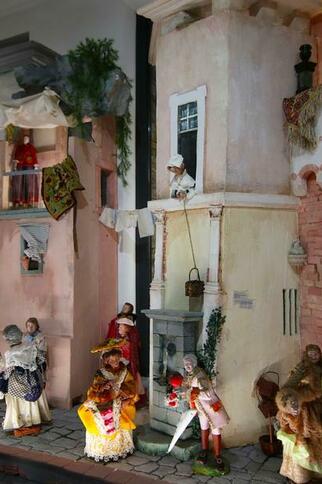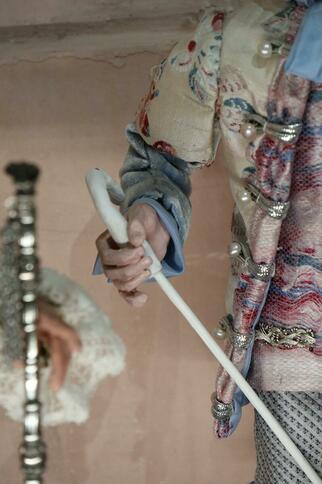Gassin
From Monday 9 December to Sunday 2 February 2025
Following the success of its 1st public presentation, artist Christian Ganga's exceptional Neapolitan nativty scene is presented with renewed decorations, new santons and new scenes between baroque exuberance, popular devotion and secular theatricality. The Event
Gassin is a perched medieval village in the heart of the Saint-Tropez peninsula. Its typical Provençal charm is perfect for leisurely strolls, especially during the Christmas season.
For the holiday festivities, the Gassin Tourist Office is hosting an original and unique creation:Christian-Léandre Ganga’s Neapolitan Nativity Scene. After the success of the first public presentation of this masterpiece, which took over 10 years to complete, this new exhibition features completely redesigned settings and a larger display space.
This exhibition coincides with the reopening of Notre-Dame Cathedral in Paris, which also features a Neapolitan Nativity Scene by Alberto Ravaglioli. Come and marvel at this unique composition in the stunning setting of one of France’s Most Beautiful Villages.
Neapolitan Nativity Scenes
The Neapolitan Nativity Scene (presebbio napulitano) is a traditional craft that emerged in the late 16th century. It gained popularity as a social phenomenon and reached its golden age in the 18th century. The theatricality of these nativity scenes is their hallmark, blending sacred elements with everyday life, as figures from daily life join the biblical story.
By the early 17th century, this tradition took root in Naples, combining the advent of Christianity with ruins of the ancient world. The inclusion of the Magi, surrounded by their court and servants, is a unique feature of Neapolitan nativity scenes.
In the 18th century, creating elaborate nativity scenes became a passion for Naples’ aristocracy and bourgeoisie. Families competed to design ever more intricate and grandiose displays. This cultural fervor fostered the development of a high-end craft industry, with Naples' finest sculptors contributing their artistry. Notably, King Charles VII of Naples and Queen Maria Amalia themselves devoted leisure time to making nativity figurines.
Neapolitan nativity scenes are known for their baroque extravagance. Figures are magnificently sculpted and dressed in luxurious, vibrant costumes. The figurines (pastori), about 40 cm tall, have articulated wooden limbs and frames made of wire and tow. Their clothing reflects their social standing, ranging from opulent silk adorned with gold trims and jewels to simple shepherd’s vests.
Each scene is a masterful blend of perspective and chiaroscuro, bringing the nativity to life. The figures include quintessential characters like noblemen, shepherds, and townsfolk, each realistically expressive and historically detailed.
Nativity Scenes: 800 Years of Art
It was in Greccio, in 1223, that Saint Francis of Assisi conceived the modern nativity scene. Inspired by his visit to Bethlehem's Church of the Nativity, he recreated the scene of Christ’s birth at his hermitage, using a manger, hay, an ox, and a donkey. This living nativity brought villagers together to experience the Christmas story, setting the precedent for today’s nativity scenes.
With the influence of Saint Clare of Assisi and the Franciscan order, the tradition spread across Christendom. Figurine-based nativity scenes, made from wood or clay, allowed the display to remain longer and became especially popular in Campania, where Neapolitan nativity scenes adorned churches by the 14th century and aristocratic homes by the 18th century.
Christian Ganga
Born in 1940 in Oran, Christian Ganga showed an early talent for drawing. In 1965, he joined the studio of Jacques Estérel, creator of Brigitte Bardot’s wedding dress, and eventually became head of the haute couture collection. Estérel's clients included luminaries like Michèle Morgan, Édith Piaf, Dalida, and Catherine Deneuve.
Ganga’s fascination with Neapolitan nativity scenes began at the Louvre des Antiquaires in Paris, leading to his collection of 18th-century pastori. While working in Italy, he expanded his collection and started crafting traditional clay figurines.
Each figurine takes about a month to create, from sculpting the body to tailoring the costume. Ganga’s favorite subjects include tradespeople and servants of the aristocracy, such as wigmakers, glovemakers, and perfumers. He emphasizes the meticulous detail in the realistic expressions of his figures, all sculpted by hand.
The costumes, made from premium fabrics, often incorporate antique materials to reflect the social status of the characters. Ganga explains:
"As a great admirer of Italy, I aim to convey the whirlwind of emotions in my nativity scene—a mirror of daily life juxtaposing the struggles of the poor with the indulgence of the wealthy."
Gassin is a perched medieval village in the heart of the Saint-Tropez peninsula. Its typical Provençal charm is perfect for leisurely strolls, especially during the Christmas season.
For the holiday festivities, the Gassin Tourist Office is hosting an original and unique creation:Christian-Léandre Ganga’s Neapolitan Nativity Scene. After the success of the first public presentation of this masterpiece, which took over 10 years to complete, this new exhibition features completely redesigned settings and a larger display space.
This exhibition coincides with the reopening of Notre-Dame Cathedral in Paris, which also features a Neapolitan Nativity Scene by Alberto Ravaglioli. Come and marvel at this unique composition in the stunning setting of one of France’s Most Beautiful Villages.
Neapolitan Nativity Scenes
The Neapolitan Nativity Scene (presebbio napulitano) is a traditional craft that emerged in the late 16th century. It gained popularity as a social phenomenon and reached its golden age in the 18th century. The theatricality of these nativity scenes is their hallmark, blending sacred elements with everyday life, as figures from daily life join the biblical story.
By the early 17th century, this tradition took root in Naples, combining the advent of Christianity with ruins of the ancient world. The inclusion of the Magi, surrounded by their court and servants, is a unique feature of Neapolitan nativity scenes.
In the 18th century, creating elaborate nativity scenes became a passion for Naples’ aristocracy and bourgeoisie. Families competed to design ever more intricate and grandiose displays. This cultural fervor fostered the development of a high-end craft industry, with Naples' finest sculptors contributing their artistry. Notably, King Charles VII of Naples and Queen Maria Amalia themselves devoted leisure time to making nativity figurines.
Neapolitan nativity scenes are known for their baroque extravagance. Figures are magnificently sculpted and dressed in luxurious, vibrant costumes. The figurines (pastori), about 40 cm tall, have articulated wooden limbs and frames made of wire and tow. Their clothing reflects their social standing, ranging from opulent silk adorned with gold trims and jewels to simple shepherd’s vests.
Each scene is a masterful blend of perspective and chiaroscuro, bringing the nativity to life. The figures include quintessential characters like noblemen, shepherds, and townsfolk, each realistically expressive and historically detailed.
Nativity Scenes: 800 Years of Art
It was in Greccio, in 1223, that Saint Francis of Assisi conceived the modern nativity scene. Inspired by his visit to Bethlehem's Church of the Nativity, he recreated the scene of Christ’s birth at his hermitage, using a manger, hay, an ox, and a donkey. This living nativity brought villagers together to experience the Christmas story, setting the precedent for today’s nativity scenes.
With the influence of Saint Clare of Assisi and the Franciscan order, the tradition spread across Christendom. Figurine-based nativity scenes, made from wood or clay, allowed the display to remain longer and became especially popular in Campania, where Neapolitan nativity scenes adorned churches by the 14th century and aristocratic homes by the 18th century.
Christian Ganga
Born in 1940 in Oran, Christian Ganga showed an early talent for drawing. In 1965, he joined the studio of Jacques Estérel, creator of Brigitte Bardot’s wedding dress, and eventually became head of the haute couture collection. Estérel's clients included luminaries like Michèle Morgan, Édith Piaf, Dalida, and Catherine Deneuve.
Ganga’s fascination with Neapolitan nativity scenes began at the Louvre des Antiquaires in Paris, leading to his collection of 18th-century pastori. While working in Italy, he expanded his collection and started crafting traditional clay figurines.
Each figurine takes about a month to create, from sculpting the body to tailoring the costume. Ganga’s favorite subjects include tradespeople and servants of the aristocracy, such as wigmakers, glovemakers, and perfumers. He emphasizes the meticulous detail in the realistic expressions of his figures, all sculpted by hand.
The costumes, made from premium fabrics, often incorporate antique materials to reflect the social status of the characters. Ganga explains:
"As a great admirer of Italy, I aim to convey the whirlwind of emotions in my nativity scene—a mirror of daily life juxtaposing the struggles of the poor with the indulgence of the wealthy."
Prestations
Free of charge.
€
to €
EUR
EUR
- Mountain view
- Village centre
- View over the vineyards
- German
- English
- French
- Italian
- Terrace
- Air conditioning
- Car park
- Orientation board
- Sustainable development
- Parking
- Waste management
- photocopier
- Charging stations for electric vehicles
- Free car park
- Parking 2 roues
- Pets welcome
- Tourist information
- Tour free of charge
Address
Office de tourisme de Gassin
20, place Léon Martel
Montée Saint-Joseph
83580 Gassin
Montée Saint-Joseph
83580 Gassin
Opening
From 09/12/2024 to 02/02/2025
Opening hours on Monday, Tuesday, Wednesday, Thursday and Friday between 9 am and 12 pm and between 2 pm and 5 pm. On Saturday and Sunday between 2 pm and 6 pm. except on January 1st and December 25th.
-
December 2024
L M M J V S D -
January 2025
L M M J V S D -
February 2025
L M M J V S D -
March 2025
L M M J V S D -
April 2025
L M M J V S D -
May 2025
L M M J V S D -
June 2025
L M M J V S D -
July 2025
L M M J V S D -
August 2025
L M M J V S D -
September 2025
L M M J V S D -
October 2025
L M M J V S D -
November 2025
L M M J V S D









































